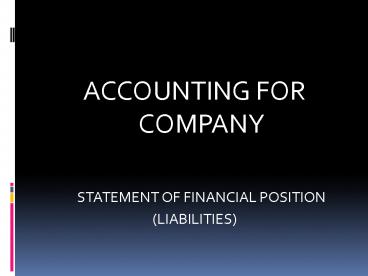ACCOUNTING FOR COMPANY - PowerPoint PPT Presentation
1 / 11
Title:
ACCOUNTING FOR COMPANY
Description:
ACCOUNTING FOR COMPANY ... A liability is a present obligation of the entity arising from past events, ... Company: Universiti Putra Malaysia – PowerPoint PPT presentation
Number of Views:98
Avg rating:3.0/5.0
Title: ACCOUNTING FOR COMPANY
1
- ACCOUNTING FOR COMPANY
- STATEMENT OF FINANCIAL POSITION
- (LIABILITIES)
2
Learning outcomes
- Understand the accounting items assets,
liabilities and owners equity - Understand the recognitions, classifications and
measurements of accounting items assets,
liabilities and owners equity
3
Liabilities
- Defintion A liability is a present obligation of
the entity arising from past events, the
settlement of which is expected to result in an
outflow from the entity of resources embodying
economic benefits.
4
Recognition
- Recognition is the process of incorporating in
the balance sheet or income statement an item
that meets the definition of an element and
satisfies the following criteria for recognition - It is probable that any future economic benefit
associated with the item will flow to or from the
entity and - The item's cost or value can be measured with
reliability. - A liability is recognised in the balance sheet
when it is probable that an outflow of resources
embodying economic benefits will result from the
settlement of a present obligation and the amount
at which the settlement will take place can be
measured reliably.
5
Measurement
- Measurement involves assigning monetary amounts
at which the elements of the financial statements
are to be recognised and reported. F 4.54 - The IFRS Framework acknowledges that a variety of
measurement bases are used today to different
degrees and in varying combinations in financial
statements, including F 4.55 - Historical cost
- Current cost
- Net realisable (settlement) value
- Present value (discounted)
- Historical cost is the measurement basis most
commonly used today, but it is usually combined
with other measurement bases. F. 4.56
6
Classification
- An entity must normally present a classified
statement of financial position, separating
current and noncurrent assets and liabilities,
unless a presentation based on liquidity is more
relevant. - Current liabilities are those to be settled
within the entity's normal operating cycle or due
within 12 months, or those held for trading, or
those for which the entity does not have an
unconditional right to defer payment beyond 12
months. Other liabilities are noncurrent.
7
Minimum items on the face of the Statement of
Financial Position IAS 1.54
- Liabilities the amounts payable or redeemable
within the next 12 months and those payable or
redeemable later than 12 months must be
distinguished. Liabilities must be shown
separately under the following headings. - Debentures, those secured and not secured
- Liabilities charged on the assets of the company
- Bank loans, overdrafts and other loans,
distinguished between those which are secured and
unsecured - Other unsecured borrowings
- Provision for retirement benefits
- Deferred tax liability
8
Cont.
- Other liabilities and provisions
- Trade creditors
- Amounts owing to a director
- Amounts owing to the holding/subsidiaries
- Amounts owing to related corporations
- Other amounts owing by company
9
Items of liabilities
- Debentures
- Debentures are loan capital with a fixed rate of
interest payable by the company to the debenture
holders regardless of the performance of the
company. - It may be redeemable, i.e., repayable at or by a
specified time. - It may be convertible, i.e., to be converted into
ordinary shares at or by a specified date. - It can be traded in BM, thus, the rights are
transferable. - Debentures are often secured on certain assets of
the company. - Implication if the company unable to pay
interest or fails to repay the loan on the due
date- the trustee can take possession of the
asset and sell it to repay the debenture
holders. - On the face of SFP - State (in bracket) whether
it is charged over the assets of the company or
not
10
Cont.
- Deferred tax liability
- It arises because the tax payable as calculated
for the current year according to the tax rules
is different form the tax payable according to
accounting rules. - The reason is that certain income and expenses
recognised in the current year in the companys
accounts may only be recognised for tax purposes
at a different amount or at an earlier or later
date. - e.g. Accrued interest expense recognised in
the current accounting period according to
accrual concepts in accounting. However, IRD will
allow interest expense as an allowable deduction
only when it is paid (cash basis). Thus, taxable
profit and accounting profit will be different. - FRS112 Income Taxes- Deferred tax liability to be
disclosed in the year-end SFP must be calculated.
Then, the difference between the opening and
closing balances of deferred tax liability will
be disclosed in the SCI either as an addition or
deduction to the tax payable.
11
Cont.
- Other liabilities
- Tax payable
- Dividend payable to be discussed after topic on
equity.































